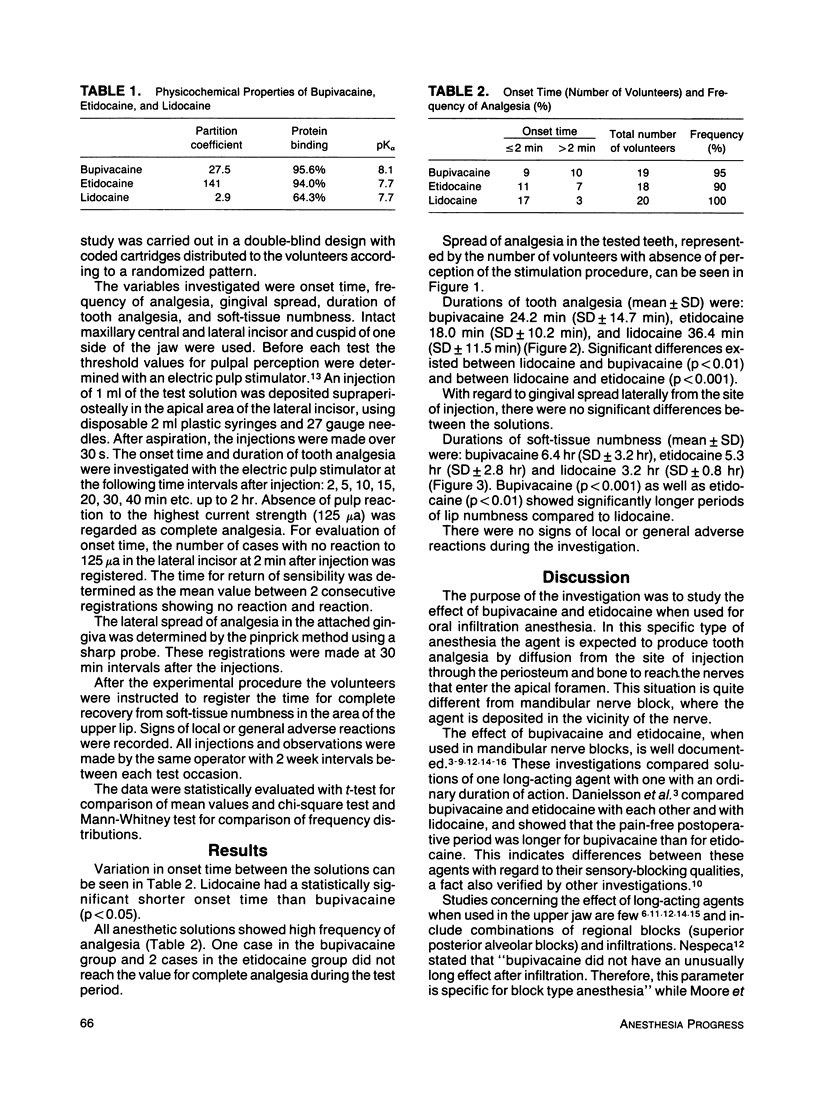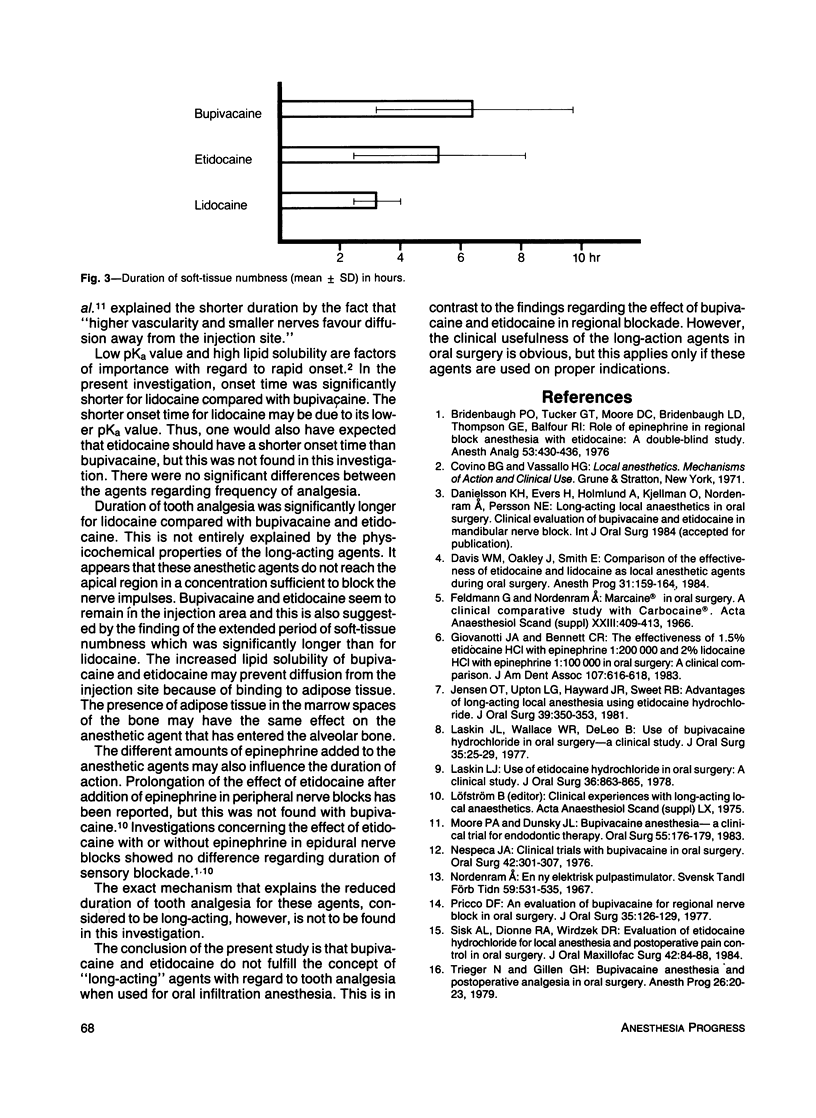Abstract
The effect of bupivacaine 7.5 mg/ml with epinephrine 5μg/ml, etidocaine 15 mg/ml with epinephrine 5 μg/ml, and lidocaine 20 mg/ml with epinephrine 12.5 μg/ml was studied when used for oral infiltration anesthesia. Twenty healthy volunteers took part in the experimental and double-blind study. One ml of the respective anesthetic solution was deposited supraperiosteally in the apical area of the maxillary right lateral incisor. Onset time, frequency of analgesia, gingival spread, and duration of tooth analgesia were studied and duration of soft-tissue numbness registered. The present investigation showed that lidocaine had a shorter onset time compared with bupivacaine. No difference with regard to frequency was found. Bupivacaine and etidocaine had a longer period of soft-tissue numbness, but a significantly shorter duration of tooth analgesia than lidocaine.
Full text
PDF



Selected References
These references are in PubMed. This may not be the complete list of references from this article.
- Bridenbaugh P. O., Tucker G. T., Moore D. C., Bridenbaugh L. D., Thompson G. E., Balfour R. I. Role of epinephrine in regional block anesthesia with etidocaine: a double-blind study. Anesth Analg. 1974 May-Jun;53(3):430–436. [PubMed] [Google Scholar]
- Davis W. M., Jr, Oakley J., Smith E. Comparison of the effectiveness of etidocaine and lidocaine as local anesthetic agents during oral surgery. Anesth Prog. 1984 Jul-Aug;31(4):159–164. [PMC free article] [PubMed] [Google Scholar]
- Feldmann G., Nordenram A. Marcaine in oral surgery. A clinical comparative study with carbocaine. Acta Anaesthesiol Scand Suppl. 1966;23:409–413. [PubMed] [Google Scholar]
- Giovannitti J. A., Bennett C. R. The effectiveness of 1.5% etidocaine HCl with epinephrine 1:200,000 and 2% lidocaine HCl with epinephrine 1:100,000 in oral surgery: a clinical comparison. J Am Dent Assoc. 1983 Oct;107(4):616–618. doi: 10.14219/jada.archive.1983.0299. [DOI] [PubMed] [Google Scholar]
- Jensen O. T., Upton L. G., Hayward J. R., Sweet R. B. Advantages of long-acting local anesthesia using etidocaine hydrochloride. J Oral Surg. 1981 May;39(5):350–353. [PubMed] [Google Scholar]
- Laskin J. L. Use of etidocaine hydrochloride in oral surgery: a clinical study. J Oral Surg. 1978 Nov;36(11):863–865. [PubMed] [Google Scholar]
- Laskin J. L., Wallace W. R., DeLeo B. Use of bupivacaine hydrochloride in oral surgery-a clinical study. J Oral Surg. 1977 Jan;35(1):25–29. [PubMed] [Google Scholar]
- Moore P. A., Dunsky J. L. Bupivacaine anesthesia--a clinical trial for endodontic therapy. Oral Surg Oral Med Oral Pathol. 1983 Feb;55(2):176–179. doi: 10.1016/0030-4220(83)90175-5. [DOI] [PubMed] [Google Scholar]
- Nespeca J. A. Clinical trials with bupivacaine in oral surgery. Oral Surg Oral Med Oral Pathol. 1976 Sep;42(3):301–307. doi: 10.1016/0030-4220(76)90163-8. [DOI] [PubMed] [Google Scholar]
- Nordenram A. En ny elektrisk pulpastimulator. Sver Tandlakarforb Tidn. 1967 Jun 15;59(12):531–535. [PubMed] [Google Scholar]
- Pricco D. F. An evaluation of bupivacaine for regional nerve block in oral surgery. J Oral Surg. 1977 Feb;35(2):126–129. [PubMed] [Google Scholar]
- Sisk A. L., Dionne R. A., Wirdzek P. R. Evaluation of etidocaine hydrochloride for local anesthesia and postoperative pain control in oral surgery. J Oral Maxillofac Surg. 1984 Feb;42(2):84–88. doi: 10.1016/0278-2391(84)90316-1. [DOI] [PubMed] [Google Scholar]
- Trieger N., Gillen G. H. Bupivacaine anesthesia and post-operative analgesia in oral surgery. Anesth Prog. 1979 Jan-Feb;26(1):20–23. [PMC free article] [PubMed] [Google Scholar]


